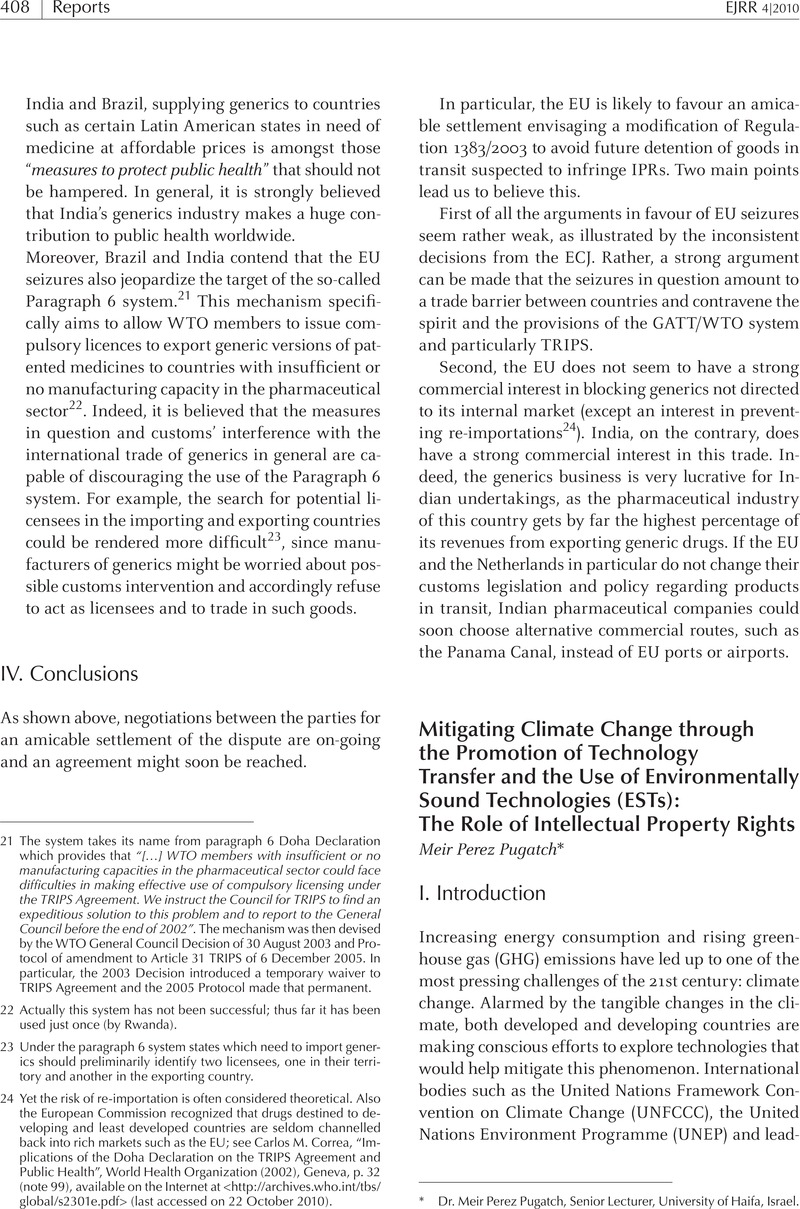Article contents
Mitigating Climate Change through the Promotion of Technology Transfer and the Use of Environmentally Sound Technologies (ESTs): The Role of Intellectual Property Rights
Published online by Cambridge University Press: 20 January 2017
Abstract

Information
- Type
- Reports
- Information
- Copyright
- Copyright © Cambridge University Press 2010
References
1 For instance, the Kyoto Protocol (signed in 1997; entered into force in 2005) committed its signatories to reducing GHG emissions either through national reductions or other mechanisms. See, UNFCCC, “Kyoto Protocol”, available on the Internet at <http://unfccc.int/kyoto_protocol/items/2830.php>.
2 The project was announced on 24 April 2009 and on the World Intellectual Property Day (26 April 2009). Further details about the project as a whole can be found at UNEP, EPO and ICTSD websites, for example, at <http://www.unep.ch/etb/initiatives/Patents_ESTs.php> and <http://ictsd.org/i/environment/iprs/51361/?view=document> (last accessed on 13 October 2010). A description of the project is available on the Internet at <http://www.unep.ch/etb/initiatives/pdf/ESTsProject%20Description1.pdf> (last accessed on 13 October 2010).
3 The above definition is based on Chapter 34 of Agenda 21 of the UN Program on Sustainable Development.
4 Meir Pugatch, Survey of Licensing Activities in Selected Fields of Environmentally Sound Technologies (ESTs). Submitted to the United Nations Environment Programme (UNEP), the European Patent Office (EPO), and the International Centre for Trade and Sustainable Development (ICTSD) (January 2010).
5 UNEP, EPO, ICTSD, Patent and Clean Energy: Bridging the Gap Between Evidence and Policy (Munich: EPO, October 2010), available on the Internet at <http://www.epo.org/topics/issues/cleanenergy/study.html> (last accessed on 3 November 2010).
6 This term refers to the responding organizations that have reported that ESTs-related patents constitute either a substantial or significant part of their overall patent portfolio.
7 See Dieter Ernst, Innovation Offshoring: Asia's Emerging Role in Global Innovation Networks, 10 East West Center Special Reports (Honolulu: East West Center 2006).
8 Such efforts are broadly aimed at jointly creating new knowledge and technologies by two entities or more.
9 Broadly speaking such mechanisms are aimed at preventing legal disputes between entities on the basis of possible violations of IPRs and/or by creating a space for the use of IPRs that are owned by different entities for the purpose of further technological development.
10 This term refers to the share of responding organizations reporting that during the last three years they have occasionally or frequently entered into licensing agreements which involve recipients based in developing countries.
11 See the Kyoto Protocol (available on the Internet at <http://unfccc.int/kyoto_protocol/items/2830.php>) and subsequent agreements, such as the Copenhagen Accord (available on the Internet at <http://unfccc.int/home/items/5262.php>).
12 Bonadio, Enrico, “Climate Change and Intellectual Property”, 1(1) European Journal of Risk Regulation (2010), pp. 72–76.CrossRefGoogle Scholar
13 Ibid., at p. 72.
14 Lee, Bernice, Iliev, Ilian and Preston, Felix, Who Owns Our Low Carbon Future? Intellectual Property and Energy Technologies (London: Chatham House 2009).Google Scholar
15 International Energy Agency, “Technology Without Borders. Case Studies of Successful Technology Transfer”, 2001, available on the Internet at <http://www.iea.org/textbase/nppdf/free/2000/ctifull2001.pdf> (last accessed on 13 October 2010).
16 Ibid., p. 108.
17 As shown above, this is not the case as far as China, India and Brazil are concerned.
- 2
- Cited by

